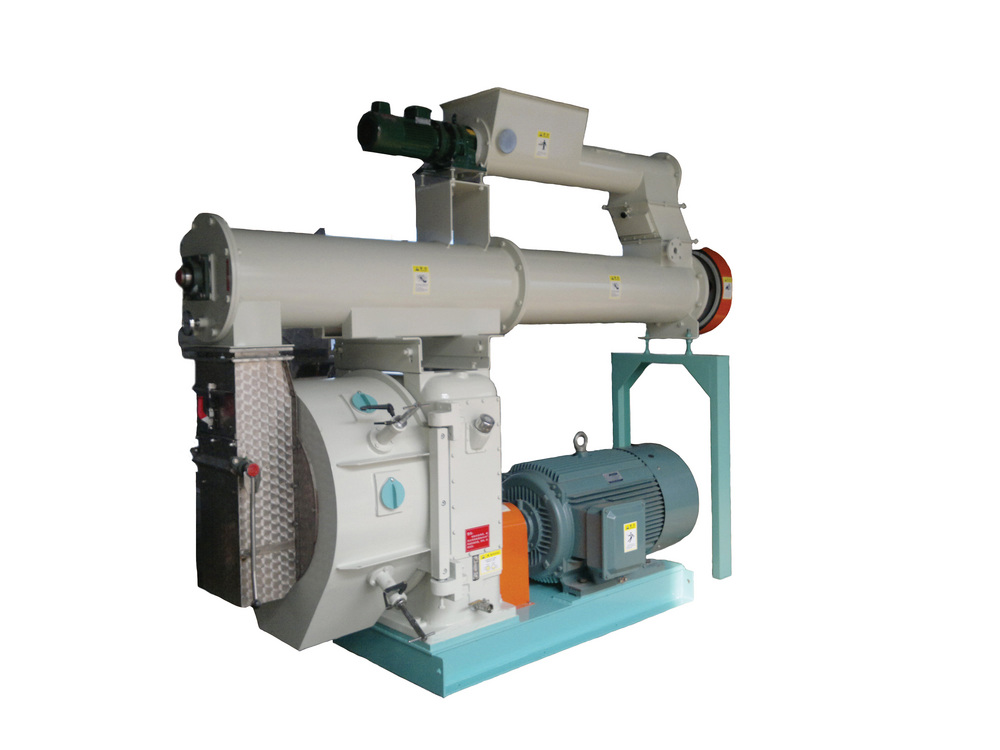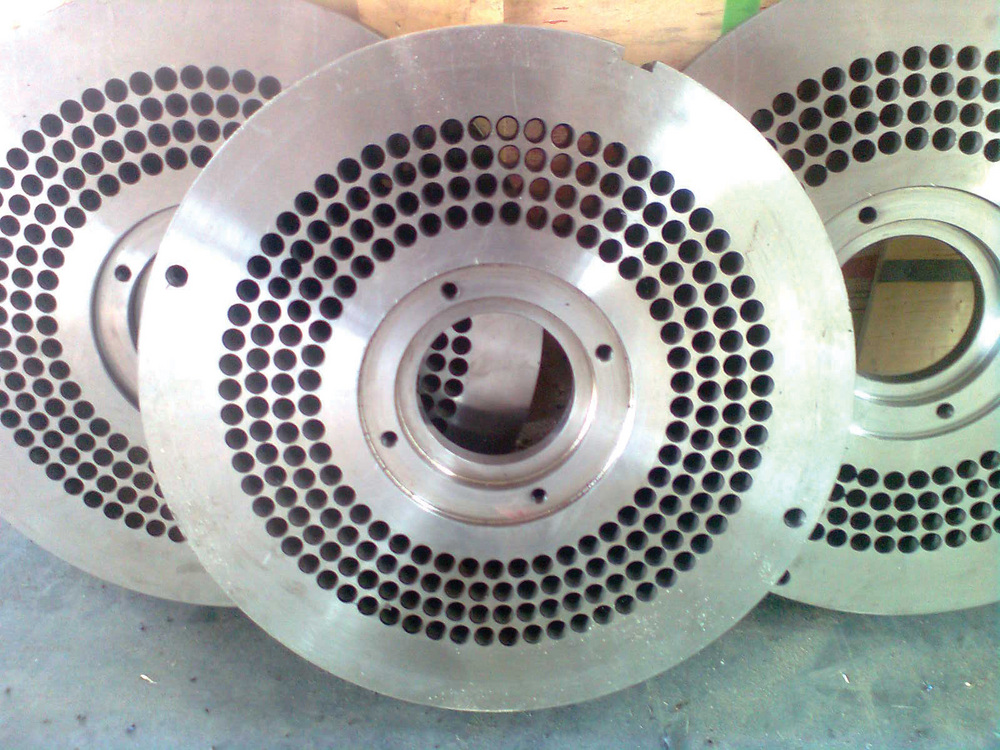Pellet Mill Repair: Flat Die Versus Ring Die







PHOTO: AMISY
January 7, 2013
BY Linda Zhu
Flat die and ring die pellet mills are the two major designs used in global biomass pellet manufacturing. Each design has its own characteristics and advantages, so in order to select appropriate machinery based on production requirements, as well as efficient maintenance and repair work later on, the features of each should be investigated.
The Flat Die Design
Flat die pellet mills work on a unique vertical design, using gravity as the main force for feeding material through the machine. It hosts a horizontal die with a series of rollers above it, and a screw-center adjusting pressure structure that makes it the more practical pellet mill. The pressed rollers' gap can be adjusted slightly bigger or smaller, and the pellet compression ratio is also adjustable, enabling a manufacturer to meet different pelletizing requirements. Meanwhile, this design greatly reduces pressure to the die and avoids unnecessary malfunction.
There are two different designs of flat die pellet mill that can make it widely applicable and durable. The first has a rotating die with a stationary roller shaft, and the other has a stationary die with a rotating roller shaft. These two different designs have their own unique features, so one should choose the design according to the raw materials. Generally speaking, if you want to make biomass pellets, you should choose the type with rotating rollers and stationary die.
The Ring Die Design
The ring die pellet mill has a sophisticated structure design, the die mold and roller being the most important components. The ring die is drilled with many holes and encloses two rollers fixed on a support. After hardening and tempering, materials enter the ring die cover through inclined channel.
After continuous use and wear, the ring die needs to be changed to guarantee the smooth operation, and it also needs to be equipped with an imperative feeding device. As materials such as wood sawdust, corn, wheat, rice and straw are very light, they need to be pushed into the pelletizing chamber by force. Unlike flat die pellet mills with gravity principles, ring die pellet mills need a feeder device that ensures the machine operates smoothly, allowing for continuous and efficient production.
The compression rate of a ring die pellet mill cannot be adjusted. Flat die pellet mills ensure an adjustable compression rate that protects the die to a degree, but the uncontrollable pressure of ring die pellet mill, triggered by structural constraints, can suppress materials beyond the pressure load, leading to a broken roller bearing.
Understanding the design of both a ring die pellet mill and flat die pellet mill, how does one maintain and repair a pellet mill in the “right” way?
Advertisement
Maintainence and Repair
After reviewing the pellet mill design and characteristics, it’s important to be aware that operation and maintenance of a machine is also very important because the right use of a pellet mill directly affects the economic benefit. With a flat die pellet mill, one will find that it is easier to access the pellet mill chamber, compared to the ring die pellet mill, while the worn die needs to be changed. Flat die pellet mills have the advantage of the adjustable compression rate, which can reduce roller shell wear, and are significantly superior in the five main areas of to machinery maintenance and repair, the first is consistently checking easy-wear parts.
For a flat die pellet mill, checking the quick-wear parts at a regular time is easy to do because of its simple design; for the ring die pellet mill, irregularly scheduled inspection is required, and is more challenging due to its complicated structure.
Regularly adding oil to transmission parts is another important component of maintenance and repair. All transmission parts should be lubricated at a fixed time to ensure long service, and all component parts should also be checked carefully, on a weekly basis especially to determine whether connected parts are loose and if the stroke switch can operate reliably. Regularly cleaning of the screw conveyor and conditioner is also necessary.
The next and most important aspect of the pelletizing process is the selection of a suitable compression ratio. One should choose different compression ratios according to different materials. so as to improve capacity and reduce wear.
Last, regularly changing the lubricating oil of the gearbox will lengthen service life.
Solving Common Malfunctions
After functioning for a period of time, both the ring die and flat die will wear. If the die mold isn’t changed when it should be, it will directly affect the productivity and pellet quality. Regularly removing and replacing the die is necessary for both flat die pellet mill and ring die pellet mill, but the process for replacing a ring die is troublesome due to the heavy weight of the die the complicated design of the machine.
Like the die mold, the roller shell is an easy-wear part. Compared with a flat die pellet mill, the roller shell of ring die pellet mill is easier broken, due to uncontrollable pressure. At this point, the flat die pellet mill has an outstanding advantage of an adjustable compression rate, which can reduce roller shell wear.
Bearing lubrication is very important for all machines. To reduce damage to bearings and ensure they are in normal condition, they should be regularly lubricated. Going too far, however, is as bad as not going far enough: too much oil can also cause damage to a bearing.
Advertisement
Overloading can cause great damage to both the reduction gear and motor, so it must be avoided. If it does happen, broken parts should be quickly repaired or changed.
Finally, the gap between ring die and pressure roller should be regularly adjusted to avoid violent vibration damage to the transmission parts and bearing guard.
While the aforementioned recommendations will help prevent malfunctions, a flat die pellet mill has several advantages when it comes to repair.
Flat Die Pellet Mill Repair Advantages
Pellet mill repair is an important area of focus. While each design has its own advantages and disadvantages regarding repair, decades of practical experience and professional feedback indicate the flat die pellet mill is incomparably superior: its structural design is simple, it is easy to operate, move and maintain, and the failure rate is lower.
Because the flat die pellet mill is structured with a pressure-adjusting screw center, the size of the pressed roller gap can be adjusted smaller or bigger to meet the demand of different materials—even coarse and difficult-to-process materials can be pelletized. The ring die pellet mill, however, is diametrically opposite. The pressure of coarse and difficult materials combined with its nonadjustable design may increase the need for repairs and their attendant costs.
Replacement parts for a flat die pellet mill are less expensive than parts for a ring die pellet mill, due to the more complex design of the ring die mill, whose equipment is heavy and particular, and consequently more expensive to replace, especially in the production line. When wear and tear occur in ring die pellet mill parts, usage and maintenance costs will be much higher than those of a flat die pellet mill.
Systematic staff training is indispensable for the pelletizing industry. Staff training at a flat die pellet mill is much easier––the machine is easier to operate, compared with ring die pellet mill, so staff training will not be as complicated. Based on the simple structure design and easy-to-move characteristic of flat die pellet mills, personnel can master repair techniques and carry out them out professionally and efficiently.
As a final comparison, the changing of a pellet mill roller and die is easier in a flat die pellet mill, as the pellet mill chamber is more accessible, thereby saving time when changing the die. By contrast, changing out a worn ring die in a ring die pellet mill is a rather complicated process.
In conclusion, proper operation and maintenance is the key to extending the service life of pellet mills, so maintenance and repair must be carried out properly to achieve a high product output, consuming less time and increasing corporate profits.
Author: Linda Zhu
Zhengzhou Amisy Machinery
info@pellets-mill.com
http://www.pellets-mill.com
Upcoming Events





